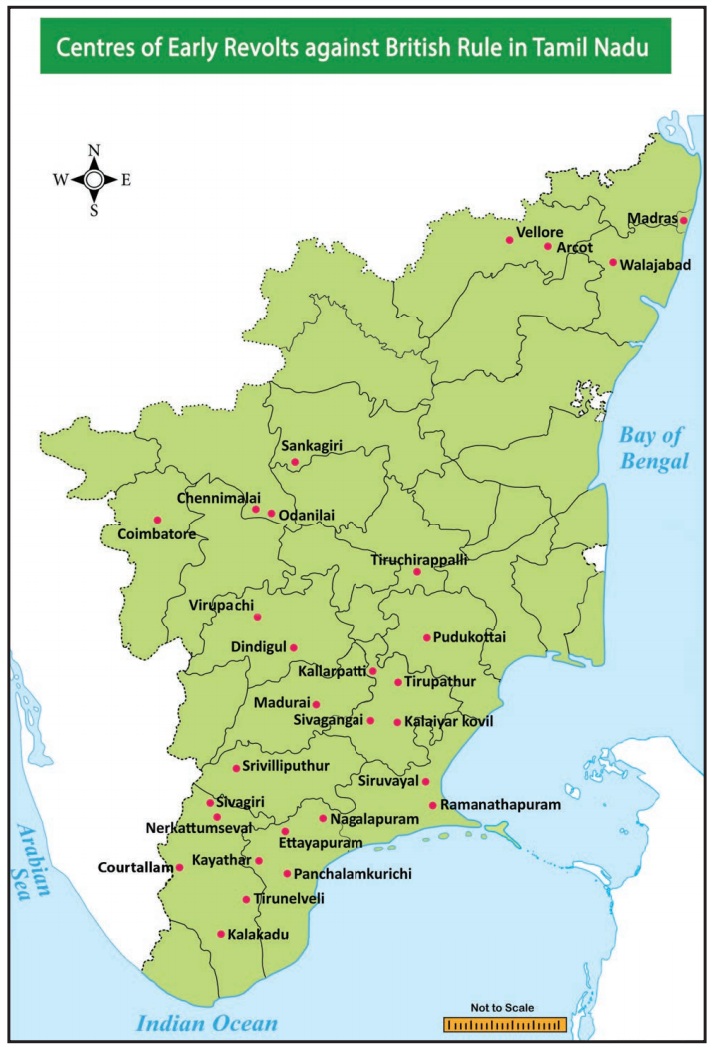Early Revolts against British Rule in Tamil Nadu - Vellore Revolt 1806 | 10th Social Science : History : Chapter 6 : Early Revolts against British Rule in Tamil Nadu
Chapter: 10th Social Science : History : Chapter 6 : Early Revolts against British Rule in Tamil Nadu
Vellore Revolt 1806
Vellore Revolt 1806
Before
reducing all palayakkarars of south Tamilnadu into submission the East India
Company had acquired the revenue districts of Salem, Dindigul at the conclusion
of the war with Tipu in 1792. Coimbatore was annexed at the end of the
Anglo-Mysore War in 1799. In the same year the Raja of Thanjavur whose status
had been reduced to that of a vassal in 1798 gave up his sovereign rights over
that region to the English. After the suppression of resistance of Kattabomman
(1799) and Marudhu Brothers (1801), the British charged the Nawab of Arcot with
disloyalty and forced a treaty on him. According to this Treaty of 1801, the
Nawab was to cede the districts of North Arcot, South Arcot, Tiruchirappalli,
Madurai and Tirunelveli to the Company and transfer all the administrative
powers to it.
(a) Grievances of Indian Soldiers
But the
resistance did not die down. The dispossessed little kings and feudal
chieftains continued to deliberate on the future course of action against the
Company Government. The outcome was the Vellore Revolt of 1806. The objective
conditions for a last ditch fight existed on the eve of the revolt. The sepoys
in the British Indian army nursed a strong sense of resentment over low salary
and poor prospects of promotion. The English army officers’ scant respect for
the social and religious sentiments of the Indian sepoys also angered them. The
state of peasantry from which class the sepoys had been recruited also bothered
them much. With new experiments in land tenures causing unsettled conditions
and famine breaking out in 1805 many of the sepoys’ families were in dire
economic straits. The most opportune situation come with the sons and the
family members of Tipu being interned in Vellore Fort. The trigger for the
revolt came in the form of a new military regulation notified by the
Commander-in-Chief Sir John Cradock.
According
to the new regulations, the Indian soldiers were asked not to wear caste marks
or ear rings when in uniform. They were to be cleanly shaven on the chin and
maintain uniformity about how their moustache looked. The new turban added fuel
to fire. The most objectionable addition was the leather cockade made of animal
skin. The sepoys gave enough forewarning by refusing to wear the new turban.
Yet the Company administration did not take heed.
(b) Outbreak of the Revolt
On 10 July 1806, in the early hours, guns were booming and the Indian sepoys of the 1st and 23rd regiments raised their standard of revolt. Colonel Fancourt, who commanded the garrison, was the first victim. Colonel MeKerras of the 23rd regiment was killed next. Major Armstrong who was passing the Fort heard the sound of firing. When he stopped to enquire he was showered with bullets. About a dozen other officers were killed within an hour or so.
Among
them Lt. Elly and Lt. Popham belonged to His Majesty’s battalion.
Gillespie’s Brutality
Major
Cootes, who was outside the Fort, informed Colonel Gillespie, the cavalry
commandant in Arcot. Gillespie reached the fort along with a squadron of
cavalry under the command of Captain Young at 9.00 am. In the meantime, the
rebels proclaimed Fateh Hyder, Tipu’s eldest son, as their new ruler and
hoisted the tiger flag of Mysore sultans in the Fort. But the uprising was
swiftly crushed by Col. Gillespie, who threw to winds all war ethics. In the
course of suppression, according to an eyewitness account, eight hundred
soldiers were found dead in the fort alone. Six hundred soldiers were kept in
confinement in Tiruchirappalli and Vellore awaiting Inquiry.
(c) Consequences of Revolt
Six of
the rebels convicted by the Court of Enquiry were blown from the guns; five
were shot dead; eight hanged. Tipu’s sons were ordered to be sent to Calcutta.
The officers and men engaged in the suppression of the revolt were rewarded
with prize money and promotion. Col. Gillespie was given 7,000 pagodas.
However, the commander–in-chief Sir John Cradock, the Adjutant General Agnew
and Governor William Bentinck were held responsible for the revolt, removed
from their office, and recalled to England. The military regulations were
treated as withdrawn.
(d) Estimate of Revolt
The Vellore Revolt failed because there was no immediate help from outside. Recent studies show that the organising part of the revolt was done perfectly by Subedars Sheik Adam and Sheik Hamid and Jamedar Sheik Hussain of the 2nd battalion of 23rd regiment and two Subedars and the Jamedar Sheik Kasim of the 1st battalion of the 1st regiment. Vellore Revolt had all the forebodings of the Great Rebellion of 1857. The only difference was that there was no civil rebellion following the mutiny. The 1806 revolt was not confined to Vellore Fort. It had its echoes in Bellary, Walajabad, Hyderabad, Bengaluru, Nandydurg, and Sankaridurg.

Related Topics